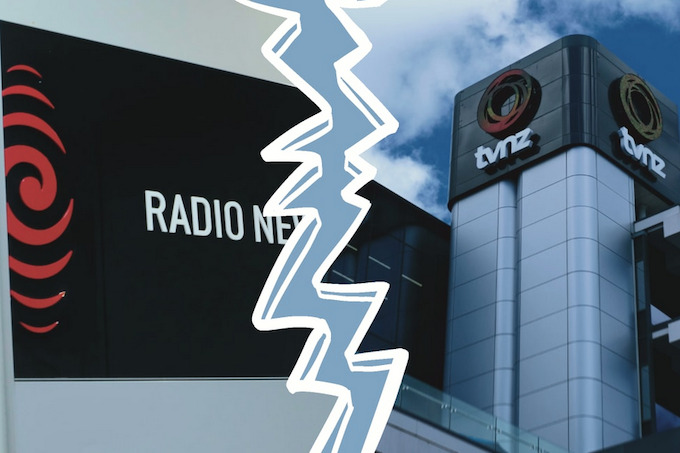
ANALYSIS: By Colin Peacock, RNZ Mediawatch presenter
Prime Minister Chris Hipkins has confirmed today what pundits have predicted for weeks: the plan for a public media entity has been scrapped — before they even settled on a name for it.
It is the second time in five years Labour has backed away from its public media policy, leaving RNZ and TVNZ in limbo again — along with less-heralded overhauls of the media.
The assumption the government would drop its plan for a new public media entity to be launched on March 1 was sparked by the then-Prime Minister Jacinda Ardern last December.
- READ MORE: Policy purge: TVNZ/RNZ merger scrapped, income insurance and hate speech laws delayed
- Other NZ media policy reports
She signalled reforms diverting ministers from the cost of living and post-Covid recovery would be shelved. She told Newsroom the so-called RNZ/TVNZ was “not number one on the government agenda”.
Broadcasting Minister Willie Jackson had already made a mess of explaining the policy in a now-notorious TVNZ interview, which also amplified sideline concerns about possible political influence.
Earlier in the year on Mediawatch, Jackson dismissed criticism of the proposed legislation, some of it coming from strong supporters of public broadcasting.
That came back to bite him last month when the parliamentary committee scrutinising the Bill rewrote important parts of it. Recent opinion polls revealed both low levels of support for the merger and little understanding of it, while rival media lobbyists called the new entity “a monolithic monster bad for the country”.
‘Reprioritised spending’
The formerly non-committal opposition leader declared it, not just bad but mad, repeatedly labeling the policy “insane”.
This year Ardern’s successor, Prime Minister Chris Hipkins, also spoke of the urgent need to “reprioritise spending” while recent reporting has almost universally described the merger as “on Chippy’s chopping block”.
Today the axe fell, finally and formally, putting a policy five years in the making out of its misery after millions of dollars and years of effort.
He said RNZ’s funding would increase in the short term “around the $10 million mark” and this could be done before the next Budget process.
RNZ put out a statement welcoming the “clarity” and the prospect of more funding. TVNZ was also “pleased to now have clarity . . . and a clear path forward for TVNZ”.
MediaWorks CEO Cam Wallace said he was pleased but too much had been spent on this proposal “at a time when the industry was dealing with decreasing advertising revenues.”
Watch live: Prime Minister Chris Hipkins has confirmed the TVNZ/RNZ merger will be scrapped https://t.co/tgagvtE68v
— RNZ News (@rnz_news) February 8, 2023
What was the plan anyway – and what went wrong?
When Kris Faafoi took over as Broadcasting Minister in late 2018, Labour junked its previous policy (launched in 2017 by then opposition leader Jacinda Ardern) of boosting RNZ with $38 million a year to become a truly multimedia public media platform — and ignoring TVNZ.
The government — through the Ministry for Culture and Heritage — launched a Strong Public Media policy instead.
Consultants who kicked off the project in 2019 concluded “the status quo is not an option”.
They said TVNZ and RNZ in their current form were not sustainable, given rapid digitally-driven changes in the media.
Covid-19 stalled the policy’s progress, but Cabinet finally agreed in 2021, greenlighting the creation of a new public media entity to replace TVNZ and RNZ.
They insisted it was not merely a merger of the two, but the enabling legislation unveiled last year was effectively just that.
Budget 2022 allocated $109 million a year until 2026 to fund the new entity’s operations, but Kris Faafoi, Willie Jackson and the PM never gave any clarity about what new services the new entity might offer.
They said yet-to-be appointed executives and governors would decide that, not ministers.
Similarly, no-one in charge convincingly addressed the fear that a hyper-commercial culture at TVNZ would clash with the charter-driven, public service MO of RNZ.
The entire process was carried almost entirely behind closed doors — and without a proper business case — until the public and other media agencies got a fortnight to make submissions on the legislation late last year.
So what next?
Effectively it will be business as usual for RNZ and TVNZ — both of which can pause plans to launch things like admin and IT services as a single system less than a month from now.
RNZ will carry on as a fully-funded bonsai-scale (by international standards) public broadcaster operating on radio and online under its existing charter (which is currently under review) with a yet-to-be announced increase in funding.
TVNZ will carry on as a possibly the world’s only commercial state-owned TV company doing news and entertainment online, which dominates the free-to-air TV market, but makes no significant money for the nation.
At all stages of the merger proposal, TVNZ has reassured advertisers it would still be open for their business. (Last year Willie Jackson chided TVNZ for dragging the chain, a claim denied by chief executive Simon Power on Mediawatch).
RNZ’s board, its chair Jim Mather and chief executive Paul Thompson, strongly backed the plan for a new entity from the early stages.
New Zealand on Air was notified last year around $80 million of its budget would be re-allocated to the new entity, forcing it to urgently pull apart its own funding plans and priorities. Today the PM also announced NZoA could expect an increase in funding.
The long-term plan
There is no long-term plan yet — beyond the status quo, which consultants and Cabinet eventually agreed was “not an option”.
But the Broadcasting Minister — who retained his portfolio in the recent reshuffle — has much to confront.
The collapse of the so-called merger goes beyond RNZ and TVNZ into other overhauls that were supposed to run in parallel with the new media entity’s creation.
Willie Jackson is also Minister of Māori Development, overseeing Māori broadcasting. He secured $80m over the past two years in extra funding for programming. But this was tied to a twice-undertaken Māori media sector shift, which was held back for — and meshed-in with — the new public media entity plan.
Jackson is also in charge of the legislative backstop to ensure tech titans Google and Meta cough up for news media content they share, a significant stream of income for under-pressure news outlets for the future.
And then there is the ongoing overhaul of the oversight of the media designed to better “protect Kiwis from harm”.
The media and online content regulation review has been run by the Department of Internal Affairs under Jan Tinetti, recently promoted to other portfolios.
This is supposed to overhaul four separate overlapping pre-digital agencies regulating the media, but is also unlikely to be “bread and butter” business for Labour in 2023.
The public media entity policy has finally been put out of its misery, but there will be consequences for kicking the can down the road again in a public media system that is still operating on 30-year-old foundations and swallowing a sizable budget for limited public returns.
This article is republished under a community partnership agreement with RNZ.












































